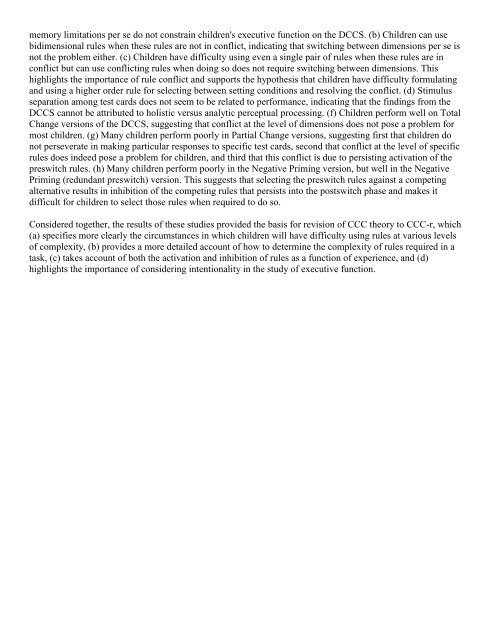THE DEVELOPMENT OF EXECUTIVE FUNCTION IN EARLY ...
THE DEVELOPMENT OF EXECUTIVE FUNCTION IN EARLY ...
THE DEVELOPMENT OF EXECUTIVE FUNCTION IN EARLY ...
Create successful ePaper yourself
Turn your PDF publications into a flip-book with our unique Google optimized e-Paper software.
memory limitations per se do not constrain children's executive function on the DCCS. (b) Children can use<br />
bidimensional rules when these rules are not in conflict, indicating that switching between dimensions per se is<br />
not the problem either. (c) Children have difficulty using even a single pair of rules when these rules are in<br />
conflict but can use conflicting rules when doing so does not require switching between dimensions. This<br />
highlights the importance of rule conflict and supports the hypothesis that children have difficulty formulating<br />
and using a higher order rule for selecting between setting conditions and resolving the conflict. (d) Stimulus<br />
separation among test cards does not seem to be related to performance, indicating that the findings from the<br />
DCCS cannot be attributed to holistic versus analytic perceptual processing. (f) Children perform well on Total<br />
Change versions of the DCCS, suggesting that conflict at the level of dimensions does not pose a problem for<br />
most children. (g) Many children perform poorly in Partial Change versions, suggesting first that children do<br />
not perseverate in making particular responses to specific test cards, second that conflict at the level of specific<br />
rules does indeed pose a problem for children, and third that this conflict is due to persisting activation of the<br />
preswitch rules. (h) Many children perform poorly in the Negative Priming version, but well in the Negative<br />
Priming (redundant preswitch) version. This suggests that selecting the preswitch rules against a competing<br />
alternative results in inhibition of the competing rules that persists into the postswitch phase and makes it<br />
difficult for children to select those rules when required to do so.<br />
Considered together, the results of these studies provided the basis for revision of CCC theory to CCC-r, which<br />
(a) specifies more clearly the circumstances in which children will have difficulty using rules at various levels<br />
of complexity, (b) provides a more detailed account of how to determine the complexity of rules required in a<br />
task, (c) takes account of both the activation and inhibition of rules as a function of experience, and (d)<br />
highlights the importance of considering intentionality in the study of executive function.
















